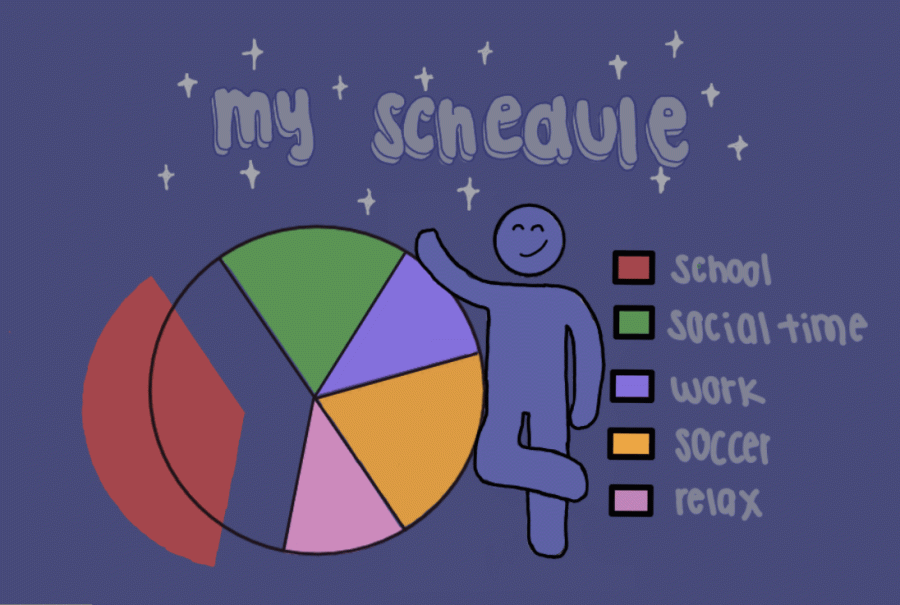Building a personalized schedule: broken down

There are only 24 hours in a day. Crafting a routine is the first step to grasping control over a personal schedule—it helps take the challenge out of an extremely rewarding process.
The 2022-23 school year is well underway, and Upper School students have cycled through the distinguishable six-day schedule nearly three times. Class request forms were due weeks before the last day of school in May, and the highly anticipated school schedules were released in early August. Tom Anderson then meticulously shifted students’ classes according to drop/add class forms and as of Sept. 9th, schedules have been solidified and are mostly inalterable. This exhaustive process is undoubtedly necessary to achieving the comprehensive course load and 4-classes-a-day schedule that SPA celebrates. But why don’t students give their own personal schedules outside the 8 a.m. – 3 p.m. school day this same attention?
The answer is likely that students feel as though they have no space in their life to customize. For many SPA students, the seven-hour school day coupled with hours of homework; plus sports or other extracurricular activities each evening leave little time for anything other than eating and sleeping. Even these necessities are oftentimes neglected. The thing about building a personal schedule, though, is that it doesn’t require adding things to the daily agenda. It simply means organizing the non-negotiable tasks in ways that feel more manageable. In fact, by crafting a schedule with routines that make life easier rather than harder, the goal is to free up time spent procrastinating or deciding how to divide the work and make it available for hobbies, rest, or self-care.
The most important part of the schedule-building process is identifying goals that a streamlined schedule will help to achieve. For example, hoping to get eight hours of sleep per night, more social time, or minimizing screen time to two hours per day are all attainable milestones to work towards. By firstly setting specific intentions, changing current routines and creating new ones becomes much more feasible.
Secondly, breaking up the day into time blocks facilitates the visualization of each chunk of the day. Grab a piece of paper and section out daily activities, leaving nothing out. Determining what tasks or activities must be completed on any given day, as well as how long they take, provides a sense of organization. After deciding what needs to get done, it is time to decide when to do it. Using this visual aid, try utilizing a planner or online calendar. Map out each activity, testing out different orders of activities until one fits.
Thirdly, allow time to adapt to a new schedule. The average human takes about two months to form a habit, which can feel like a long time. Until the routines built into this new schedule become second nature, self-discipline serves a vital role. It might not be easy, but it will pay off.
Finally, don’t neglect morning and night routines. The hour after waking up and before going to bed each night are building blocks for the tone of the following day, and greatly inform the course of that day’s schedule. Solidify a sleep schedule, and stick to it. Build in time to wind down for the night and wake up in the morning. Try sleep meditations, different alarm sounds, Do Not Disturb, or morning journaling.
Remember that as much as a personalized schedule and routines can improve day-to-day life, it is okay to have planless days, days dedicated to rest, or days full of spontaneity sprinkled in. Productivity does not inform an individual’s value or worth, and everyone can benefit from occasional breaks in routine.
Routine benefits students through maximizing time spent studying and opening the door to non-academic past times. A truly comprehensive schedule supports students’ mental health by helping them cultivate balance, and in turn, stress management, into their lives. Each individual’s schedule is unique, because what works for one person simply won’t work for someone else. There is no one “ideal routine.” Building a truly personalized schedule is a gratifying process—demanding patience, experimentation, and an open mind.
My name is Clara McKoy (she/her). I’m the director of The Rubicon Online. At school, I’m involved in Community Action and Service Club and Senior...
Ken Jaffe • Sep 20, 2022 at 9:14 am
Great article that advisors should share with their advisees.